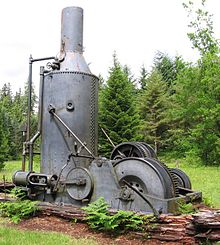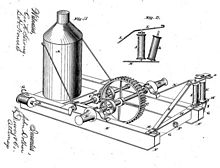Steam donkey
This article includes a list of general references, but it lacks sufficient corresponding inline citations. (September 2019) |

A steam donkey or donkey engine is a
Steam powered donkeys were commonly found on large metal-hulled multi-masted cargo vessels in the later decades of the
A donkey used in forestry, also known as a logging engine, was often attached to a yarder for hauling logs from where trees were felled to a central processing area. The operator of a donkey was known as a donkeyman.
Name
Steam donkeys acquired their name from their origin in sailing ships, where the "donkey" engine was typically a small secondary engine used to load and unload cargo and raise the larger sails with small crews, or to power pumps. They were classified by their cylinder type – simplex (single-acting cylinder) or duplex (a compound engine); by their connection to the winches (or "drums") – triple-drum, double-drum, etc.; and by their different uses.
A good deal of the cable-logging terminology derived from 19th-century merchant sailing, as much of the early technology originated in that industry. Common logging terms include high-lead yarder, ground-lead yarder, loader, snubber, and incline hoist.
History
In logging
John Dolbeer, a founding partner of the Dolbeer and Carson Lumber Company in Eureka, California, invented the logging engine in that city[1] in August 1881. The patent (number: 256553) was issued April 18, 1882. On Dolbeer's first model, a 46-metre (150 ft), 110-millimetre (4.5 in) manila rope was wrapped several times around a gypsy head (vertically mounted spool) and attached at the other end to a log.[2][3]
The invention of the steam donkey increased lumber production by enabling the transport of trees that would previously have been left behind because they were too large to move. They also enabled logging in hot or cold weather, which was not previously possible with the use of animal power.[4]
Later, the invention of the
Design
A logging donkey consists of a
The larger steam donkeys often had a "donkey house" (a makeshift shelter for the crew) built either on the skids or as a separate structure. Usually, a water tank, and sometimes a fuel oil tank, was mounted on the back of the sled. In rare cases, steam donkeys were also mounted on wheels. Later steam donkeys were built with multiple horizontally mounted drums/spools.
Use

(Patent 256,553)
In the simplest logging setup, a "line horse" would carry the cable out to a log where its tree had been downed. The cable would be attached, and, on signal, the donkey's operator (an engineer) would open the regulator, allowing the steam donkey to drag, or "skid", the log towards it. The log was taken either to a mill or to a "landing" where it would be transferred for onward shipment by railroad, road or river – either send down a flume, loaded onto boats, or floated directly in the water, often becoming part of a large log raft or "boom". Later, a "haulback" drum was added to the donkey, where a smaller cable could be routed around the "setting" and connected to the end of the heavier "mainline" to replace the line horse.
A donkey was moved by attaching one of its cables to a tree, stump or other strong anchor, then dragging itself overland to the next yarding location.
In Canada, and in particular Ontario, the donkey engine was often mounted on a barge that could float and thus winch itself over both land and water. Log booms would be winched across water with the engine, after which it would often be reconfigured with a saw to mill the timber.
Operator

A logging donkey would be operated by an engineer[11][12] called since about 1920[13] a donkey puncher.[14][15]
In later times the donkey puncher was too far away from the end of the line for verbal communication, so
The process was a closely orchestrated sequence of actions, where mistakes were often fatal and where good men stood in line for the jobs.
Other uses
Steam donkeys were also found to be useful for powering other machines such as pile drivers, slide-back loaders (also known as "slide-jammers", cranes which were used to load logs onto railroad cars and which moved along the flat-bed rail cars that were to be loaded[25]), and cherry pickers (a sled-mounted crane used for loading, onto railroad cars, logs that a grading crew had cut down). Sailing fishing vessels on the North sea operated vertical steam-driven capstans called 'the donkey' to haul fishing lines and nets, some of which are still operating today, even though converted to compressed air.
Some steamboats used a steam-driven donkey hoisting-engine with capstan, ropes and strong poles (spars) to move "walk" the boat over or away from reefs and sandbars.[26]
An auxiliary engine on a sailing craft (which does propel the vessel) is still sometimes informally known as "the donk".[citation needed]
Preserved examples

A functioning steam donkey is on display and occasionally operated at
Another steam donkey is on display along an interpretive
Another steam donkey is preserved at
Another steam donkey is preserved at
On August 1, 2009, a Steam Donkey was officially unveiled at
A wide-face steam donkey (called that because the width of the drum is greater in proportion to that in later machines) has been operational at the Tillamook County Pioneer Museum in Tillamook, Oregon, since the early 1980s. Manufactured by the Puget Sound Iron & Steel Works in the early 1900s, this donkey was abandoned in the woods when the Reiger family finished logging their land in about 1952. The steam donkey was rescued and restored from 1979 to 1981. It was donated to the Pioneer Museum by the Ned Rieger family and has been on display on the Museum grounds.
A vertical steam capstan called "donkey" for hauling fishing lines and nets is preserved on the museum fishing vessel Balder in the historic harbour of Vlaardingen (near Rotterdam), the Netherlands.
Another steam donkey is located on the Monarch Lake Loop in the Indian Peaks Wilderness near Grand Lake, Colorado on Arapaho Pass Trail #6. This steam donkey was used by the, now abandoned and flooded, town of Monarch to harvest logs from the mountain sides.[28]
See also
- "Donkey Riding"
- Donkey jacket, so named because it was worn by donkeymen
- Geared steam locomotive—often used on forestry railways
- Lidgerwood—manufacturer of steam-powered logging equipment
- Range extender – auxiliary combustion engine used on battery vehicles
- Steam power during the Industrial Revolution
- Timeline of steam power
- Yarder – a larger steam-powered logging machine
References
- ^ History of Eureka, California - Timeline of Historically Significant Events
- ^ Wilma, David (1 March 2003). "John Dolbeer invents the donkey engine and revolutionizes logging in August 1881". HistoryLink.org. Retrieved 27 February 2007.
- ISBN 0-8094-1527-5
- ISBN 978-1-85109-909-2.
- ISBN 978-0738548036.
- ^ Albrecht, Bob (2 July 2011). "Learning about the old way to log". The Columbian. Retrieved 13 September 2012.
- ISBN 0865549001.
- Chicago, Illinois: Lumber World Review; Lumber Review Company. p. 127; Volume 39.
- ISBN 978-0399604973.
- ISBN 0803292708.
- ISBN 0403021863.
- ISBN 978-0738581149.
- ISBN 978-0415212595.
- ISBN 9780802093097.
- ISBN 978-0738546797.
- ^ ISBN 978-0826427793.
- ISBN 978-1932173505.
- Beaver County Times. Pennsylvania. p. C15.
- The Vancouver Sun. p. 4.
- The Owosso Argus Press. Owosso, Michigan. Associated Press. 8 August 1921. p. 8.
- ISBN 9781550027730.
- ISBN 978-1896860466.
- Seattle, Washington. p. 3.
- ^ "Logging convoy is crossing Wyoming". Merced Sun-Star. Cheyenne, Wyoming. Associated Press. 18 May 1977. p. 15.
- ^ Frank A. King, Minnesota Logging Railroads (Minneapolis, Minnesota: University of Minnesota Press, 2003), pages 155-159.
- ^ [1] The Steamboat Era: A History Of Fulton's Folly On American Rivers, 1807-1860 | Author: S. L. Kotar | J. E. Gessler | 2009
- ^ "Historical Museum in Arnold, CA". Sierra Nevada Logging Museum. Archived from the original on 10 June 2023. Retrieved 14 July 2023.
- ^ "Town of Monarch abandoned after 4 years". Loveland Reporter-Herald. 14 July 2011. Retrieved 8 November 2021.
Further reading
- Stanley, David; Elaine Thatcher (1999). Cowboy Poets and Cowboy Poetry. ISBN 978-0252068362.
- Vaillant, John (2012). Am Ende der Wildnis: Umweltaktivist oder Ökoterrorist? (in German). Random House.
External links
- The Anatomy of a Steam Donkey (image)
- Steam Donkeys
- The Donkey Engine—Steam & Engine of Australia
- Turtle Bay Exploration Park's Dolbeer Steam Donkey (video)[dead link]
- Steam Power—Pacific County Historical Society and Museum
- Kinsey Brother Photography of the Lumber Industry—University of Washington Library
- Man to Machine: Peninsula Logging—an exhibit at the University of Washington Library
- Glossary of Logging terms, Center for the Study of the Pacific Northwest, under Donkey puncher and Whistlepunk.

